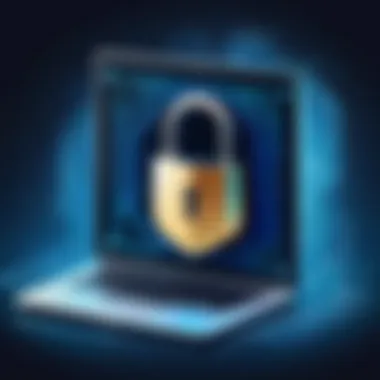Understanding SendGrid Security: Insights for Users


Intro
In the digital age, email communication is a cornerstone of business operations. SendGrid stands out as a prominent email delivery service, responsible for ensuring the secure transmission of countless messages daily. Understanding the security measures in place at SendGrid is not merely a technical necessity but a fundamental component for any organization dealing with sensitive information. In this article, we will delve into the essential security protocols that protect user data, maintain service integrity, and foster trust in this platform. This comprehensive guide aims to equip IT professionals, decision-makers, and entrepreneurs with the insights required to navigate SendGrid's security landscape.
Overview of Core Features
Description of essential functionalities
SendGrid offers a wide range of features to support secure email management. Among the core functionalities are the following:
- Email API: This allows users to send, receive, and track emails easily and securely.
- SMTP Relay: Users can authenticate and send emails through a secured channel.
- Analytics Tools: Comprehensive tracking of email metrics to help improve campaigns and ensure security compliance.
- Deliverability Features: Assurance that emails reach intended recipients without being flagged as spam.
These functionalities work together to enhance not only the user experience but also security during digital communication.
Comparison of features across top software options
When evaluating SendGrid against similar platforms, such as Mailgun and Amazon SES, there are notable differences in their security features:
- SendGrid: Strong focus on compliance, including GDPR and HIPAA, along with comprehensive encryption standards.
- Mailgun: Primarily suited for transactional emails, with decent security measures but lacks some advanced features found in SendGrid.
- Amazon SES: Offers competitive pricing but has more complex configurations that could introduce vulnerabilities if not managed properly.
Each of these services has its merits, but understanding SendGrid's robust security framework may present advantages for users who prioritize data protection.
User Experience and Interface
Insights into UI/UX design aspects
The design of SendGrid’s user interface is straightforward and intuitive, allowing users to manage emails effortlessly. The dashboard displays relevant metrics and user data prominently, making it easy to monitor email flow and detect anomalies.
Importance of usability and accessibility
Usability is crucial, particularly for organizations requiring a swift understanding of security protocols. The platform's accessible design ensures that even users with minimal technical knowledge can navigate its features effectively. Moreover, a seamless experience reduces the likelihood of errors that could lead to security breaches.
"A clear and intuitive interface is vital for maintaining security in email communication; it empowers users to act swiftly when issues arise."
Finale
With its robust security measures and user-friendly design, SendGrid offers essential tools for secure email communication. Understanding these features allows users to leverage the platform effectively while protecting sensitive data. The ongoing commitment to industry compliance and encryption signifies that SendGrid is not only a service provider but a partner in safeguarding information.
Prolusion to SendGrid Security
Email security is a critical concern for individuals and organizations alike, particularly in a digital landscape rife with threats. Understanding SendGrid security is essential for users who wish to utilize this email delivery service effectively while safeguarding sensitive information. This section aims to shed light on the security measures offered by SendGrid to ensure the integrity and confidentiality of user data.
Not only does proper email security protect against various cyber threats, but it also establishes trust with clients and stakeholders. By ensuring secure communication, businesses can boost their reputation and maintain compliance with industry regulations. Thus, the exploration of SendGrid’s security measures is not merely technical; it carries substantial implications for operational success and legal responsibility.
Background of SendGrid
SendGrid was founded in 2009 to provide a reliable cloud-based email delivery service. Over the years, it has become one of the leading platforms for transactional and marketing emails. Its emphasis on scalability and deliverability has attracted a vast number of users, including startups and large enterprises. Recognizing the importance of security, SendGrid has implemented various features that protect user accounts against unauthorized access and data breaches.
SendGrid has faced unique challenges in maintaining security protocols due to the growth in email utilization. The platform has evolved alongside emerging threats, adapting its security framework. Through a comprehensive understanding of its background, users can appreciate the progressive enhancements in security features that have been incorporated into the platform.
Importance of Email Security
Email security is vital not just for safeguarding individual user data, but also for protecting the reputation of businesses. A compromised email account can lead to data breaches, resulting in loss of sensitive information and financial repercussions. Consequently, companies must prioritize email security as part of their broader cybersecurity strategy.
The implications of inadequate email security can be dire. It can lead to loss of customer trust, damage to brand integrity, and potential legal penalties. Additionally, email is often the primary communication channel for businesses, making it a lucrative target for cybercriminals.
In this context, understanding SendGrid security becomes indispensable for users. The platform employs multiple layers of security measures designed to protect against threats, ensuring that emails are delivered securely and reliably. This focus on security not only mitigates risks but also enhances the operational credibility of businesses using SendGrid for their email communications.
"In the world of digital communication, understanding the security landscape is no longer optional; it is a necessity."
This imperative highlights the need for continuous vigilance and adaptation to new challenges in the realm of email security.
Key Security Features of SendGrid
In the era of digital communication, the importance of safeguarding email transmission cannot be overstated. SendGrid, as a leader in email delivery services, has integrated various robust security features to address potential vulnerabilities that users may encounter. This section outlines some primary elements such as Two-Factor Authentication, IP Whitelisting, and API Key Management. Each of these features plays a significant role in enhancing the overall security protocol within SendGrid's framework.
Two-Factor Authentication


Two-Factor Authentication (2FA) is a crucial line of defense against unauthorized access. It requires users to provide two distinct forms of identification before gaining access to their accounts. Typically, this process combines something the user knows, such as a password, with something the user has, often a smartphone app that generates a verification code.
Implementing 2FA substantially reduces the risk of account compromise. Even if a malicious user acquires a password, the second layer of protection will likely thwart unauthorized entry. For users managing sensitive information or operating within industries where data integrity is paramount, enabling 2FA can significantly enhance security.
IP Whitelisting
IP Whitelisting allows users to tailor access to their SendGrid accounts. By restricting access only to predefined IP addresses, users mitigate the risk of unauthorized access from unknown locations. This security feature is particularly beneficial for organizations with fixed office locations. It is easy to implement and offers a straightforward way to manage who can access account features.
However, it's critical for users to maintain an up-to-date list of whitelisted IP addresses, especially if their organization has remote workers or changes its operational base. Failing to do so may inadvertently lock out legitimate users while still providing a breach-free environment.
API Key Management
API Key Management is another essential feature that aids in securing integrations between SendGrid and other applications. Security protocols revolve around unique API keys that control access for different applications, limiting the operational reach of these keys to specific permissions required for use.
Practicing good API key management involves the following considerations:
- Regularly rotating keys: This limits the exposure time of any single key.
- Employing separate keys for different applications: Segmentation minimizes the potential for widespread damage if a key is compromised.
- Restricting key permissions: By granting only necessary access, the potential damage from a compromised key can be contained.
Data Encryption Practices
Data encryption is a fundamental component of securing information in today’s digital landscape. In the context of SendGrid, it is essential to protect sensitive data during transmission and when stored. Encryption practices play a crucial role in maintaining confidentiality and integrity of user information, ensuring that private data is not accessible to unauthorized parties. Protecting email content and user credentials is vital, especially given the increasing incidences of data breaches, phishing attacks, and other forms of cyber threats.
Transport Layer Security (TLS)
Transport Layer Security, commonly known as TLS, is an encryption protocol that provides secure communication over a computer network. Within SendGrid, TLS protects email data in transit, promoting a safe exchange between the sender and recipient. It encrypts the connection, making it extremely difficult for third parties to intercept or decipher the transmitted information.
Using TLS means that even if an email is intercepted while being sent, it is nearly impossible for the interceptor to read the contents. To implement TLS, SendGrid encourages users to send their emails through secure connections whenever possible. The adoption of TLS not only safeguards sensitive data during transmission but also enhances the overall trust users can have in the service.
It's crucial for organizations to ensure that their SendGrid settings enforce TLS for all outgoing emails to maximize their security.
Balancing the convenience of email communication with robust security measures is vital. Organizations should become familiar with configuring their SendGrid accounts for optimal TLS use, particularly for sensitive client communications or internal conversations.
Encryption at Rest
While encryption in transit is essential, encryption at rest is equally important for securing stored data. When data is kept on servers, it remains vulnerable to unauthorized access during times when it is not actively being transmitted. SendGrid employs encryption at rest to ensure that sensitive emails and information stored in their systems are encrypted and unreadable without proper authorization.
This practice provides an additional layer of security that protects data even if physical access to storage is compromised. Organizations using SendGrid should be aware that this encryption is in place, which adds peace of mind when it comes to data management. Importantly, it ensures compliance with various regulatory demands, particularly in cases involving sensitive client information.
It is recommended for users to review their data storage practices regularly, confirming that data encryption measures are both understood and effectively employed.
In summary, embracing comprehensive data encryption practices not only protects user information but also fortifies the reputation of SendGrid as a secure email delivery service. Users must recognize the significance of both TLS and encryption at rest to fully leverage these security features.
Compliance and Regulations
In today's digital environment, compliance with regulations is pivotal for organizations using email delivery platforms like SendGrid. These regulations not only provide a framework for ethical data handling but also help in building customer trust. Users must understand that abiding by these regulations is not just a legal obligation; it is a proactive approach to securing sensitive information.
General Data Protection Regulation (GDPR)
The General Data Protection Regulation, or GDPR, is a comprehensive data privacy law enacted by the European Union. It aims to protect the personal data of EU citizens and residents. For SendGrid users, compliance with GDPR is essential when dealing with European clients or customers. The regulation outlines that individuals have the right to know how their data is used, stored, and shared. It emphasizes the need for businesses to obtain explicit consent before collecting personal data.
To ensure GDPR compliance, SendGrid implements measures such as data processing agreements and the provision of tools that help users manage consent effectively. Failure to comply with GDPR can result in hefty fines and reputational damage, making it imperative for organizations to align their email practices with these guidelines.
Health Insurance Portability and Accountability Act (HIPAA)
The Health Insurance Portability and Accountability Act, commonly known as HIPAA, sets the standard for protecting sensitive patient information in the United States. For entities that handle such data, it’s critical to adhere to HIPAA regulations when using email services like SendGrid. As SendGrid is not a fully HIPAA-compliant platform out of the box, users must take additional actions to safeguard health information. This often involves signing a Business Associate Agreement (BAA) with SendGrid, which outlines how data can be used and protected.
Ensuring compliance with HIPAA not only protects patient data but also helps build credibility among healthcare clients. Organizations must regularly audit their email processes to remain compliant, given the legal implications of data breaches involving protected health information.
Payment Card Industry Data Security Standard (PCI DSS)
The Payment Card Industry Data Security Standard, or PCI DSS, is a set of security standards designed to ensure that companies that accept, process, store, or transmit credit card information maintain a secure environment. For SendGrid users who handle payment transactions, adherence to PCI DSS is crucial. This regulation requires organizations to implement measures such as secure networks, strong access control measures, and regular monitoring of all systems.
When using SendGrid, businesses must ensure that they do not send sensitive cardholder data through email. Instead, they should use secure payment gateways and follow best practices to protect sensitive customer information. Compliance signifies a commitment to customer safety and can enhance overall brand reputation within key markets.
"Navigating compliance is not just about adhering to laws; it's about integrating a culture of security into business operations."
Understanding these regulations empowers users to effectively manage their data handling practices. Compliance protects their business from legal repercussions and fosters customer trust, which is fundamental for sustainable growth.


Overall, compliance and regulations serve as the backbone of responsible data handling. For SendGrid users, familiarity with GDPR, HIPAA, and PCI DSS is non-negotiable. By prioritizing these standards, businesses ensure they meet customer expectations and create a secure operational environment.
Security Audits and Monitoring
In the context of SendGrid, security audits and monitoring play a significant role in maintaining the integrity and confidentiality of user data. They are essential to identify vulnerabilities and ensure compliance with best practices in security management. Regular evaluations not only reinforce safeguards but also help address emerging threats proactively. This continuous process leads to higher user trust and mitigates risks in email delivery.
Regular Security Audits
Regular security audits are critical in any cybersecurity framework, including SendGrid's. These audits involve thorough examinations of the security policies, controls, and protocols in place. Each audit reviews how effectively these measures protect sensitive information, looking for areas needing improvement.
The benefits of regular security audits include:
- Identifying vulnerabilities: Audit processes expose weaknesses that could be exploited by malicious actors.
- Ensuring compliance: They verify adherence to policies and regulatory requirements such as GDPR, HIPAA, and PCI DSS.
- Improving overall security posture: Through comprehensive analysis, organizations can implement measures to enhance their defenses.
- Building user confidence: Regular audits increase transparency, assuring users that their data is handled securely and responsibly.
Such audits should be done at intervals determined by risk assessment results, business needs, and regulatory guidelines. Documentation of these audits also creates a trail that showcases due diligence on the part of SendGrid.
Log Monitoring Capabilities
Log monitoring capabilities are another pivotal component of SendGrid's security ecosystem. An extensive logging system collects data on all actions taken within the platform. Effective log monitoring allows for real-time tracking and analysis of events. This can help detect suspicious activities early and respond promptly to incidents.
The significance of log monitoring includes:
- Anomaly detection: Recognizing patterns can help identify unusual behavior that signals a potential security breach.
- Historical analysis: Logs provide a historical record of access and changes made to account information, facilitating forensic investigations post-incident.
- Accountability: A robust logging system ensures that all actions can be attributed to specific users or processes, promoting responsible behavior.
- Regulatory compliance: Many regulations require that organizations maintain logs of user activity as proof of adherence to security standards.
Monitoring tools can automate tedious tasks in log management, allowing IT staff to focus on strategic security initiatives. This ultimately fortifies the security of the platform and reinforces trust with users.
"In an increasingly complex threat landscape, the need for rigorous security audits and effective log monitoring cannot be overstated."
Combining regular audits and effective log monitoring equips SendGrid with the tools needed to address security challenges swiftly and efficiently.
User Best Practices for Enhancing Security
In the realm of email communication, maintaining a fortified security posture is crucial. Users play a significant role in safeguarding both their accounts and sensitive information. Effective management of user behavior can mitigate risks associated with unauthorized access and data breaches. Key best practices can empower users to fortify their security measures in connection with SendGrid.
Managing User Permissions
An important aspect of email security is the management of user permissions. Organizations should adopt the principle of least privilege. This means granting users only the access necessary for their roles. By carefully assigning roles, insufficient access could be denied, minimizing risks of accidental or malicious data exposure.
For instance, not all employees need full administrative rights. Some may only require basic access to specific team resources. Regularly reviewing user permissions ensures only current team members have access to vital data and services. If a team member leaves, prompt action is needed to revoke their access, preventing any potential issues.
“Access controls are the first line of defense in any security strategy.”
Regular Password Updates
Regular password updates are paramount. Users should be encouraged to change their passwords at regular intervals. Utilizing complex passwords that include a mix of letters, numbers, and symbols decreases the likelihood of unauthorized access. Passwords should be unique for each account to avoid a single point of failure.
Another useful practice is to implement password managers. These tools assist users in generating and storing complicated passwords securely. Furthermore, two-factor authentication should always be used as an added layer of security. This makes it much harder for intruders to gain access, even if a password is compromised.
Awareness of Phishing Attacks
Phishing attacks are a prevalent threat that users must remain aware of. Many data breaches begin with successful phishing efforts, where attackers deceive users into providing sensitive information. Implementing training sessions on recognizing phishing attempts can decrease susceptibility.
Users should be taught to verify the sender’s email address before taking action on messages. Suspicious emails may contain links or attachments that could compromise account privacy. Encouraging skepticism regarding unsolicited communications can be a key advantage in this battle. Company policies should also be in place to report such incidents promptly.
By adhering to these user best practices, users can play an active role in enhancing SendGrid's security framework. Organizations should prioritize educating their teams to sustain a collective effort towards robust email security.
Incident Response and Recovery
Incident response and recovery are crucial aspects of any email delivery service, including SendGrid. A well-planned and executed incident response strategy can significantly mitigate the impact of security breaches and unforeseen incidents. The objective is to protect user data, restore services promptly, and maintain trust and reliability in the service.
Effective incident response not only involves immediate reactions to an incident but also preparation, detection, analysis, and recovery processes. This approach ensures a comprehensive handling of incidents, allowing organizations to recover their systems and data quickly. Taking proactive measures in this area can also prevent future vulnerabilities.
Establishing an Incident Response Plan
Creating an incident response plan is a foundational step for any organization using SendGrid. This plan lays out the procedures that the team should follow in the event of a security breach or data leak. It involves establishing roles and responsibilities for team members, enabling efficient actions whenever an incident occurs.
The plan should outline key components, such as


- Identification of potential security threats
- Assessment of the impact of incidents
- Communication strategies for informing stakeholders
- Containment measures to prevent further damage
- Eradication processes to eliminate the threat
- Recovery processes to restore normal operations
- Post-incident analysis for future improvements
Regular review and updates of the incident response plan are essential. This maintains its effectiveness against emerging threats.
Data Breach Response Procedures
In the case of a data breach, response procedures must be clearly defined to minimize the damage. These procedures dictate how to react swiftly and effectively. First, the source of the breach must be identified to understand its scope. Next,
- Initiate Containment: Limiting access to affected systems helps in preventing further data loss.
- Implement Eradication: Once contained, eradicating the threat is crucial to ensure it does not happen again.
- Notification: Regulatory requirements may necessitate informing affected users and providing them with relevant information.
- Documentation: Keeping a detailed record of the breach’s nature and impact aids in future analyses and compliance.
Finally, it is important to conduct a thorough review of the incident. This should cover what went wrong and how the incident response plan can be improved.
"An unprepared organization is at a far greater risk of incurring significant damages from a data breach than one equipped with a solid incident response strategy."
By ensuring a structured approach to incident response and recovery, SendGrid users can strengthen their security posture and minimize potential risks associated with data breaches.
Evaluating SendGrid Security in Comparison to Alternatives
When considering an email delivery service, evaluation of security protocols becomes crucial. SendGrid offers a robust email service, yet it is essential to assess its effectiveness relative to competing platforms. This process involves understanding specific elements, benefits, and considerations critical to securing communications.
Strengths and Weaknesses
SendGrid presents several strengths that make it an attractive option. First, its two-factor authentication feature adds a layer of security that many platforms might lack. This means that even if credentials are compromised, unauthorized access is still mitigated. Additionally, SendGrid's IP whitelisting is beneficial for organizations that require high security. It restricts access to known, trusted networks.
However, there are areas where SendGrid shows weaknesses. Users have reported occasional issues with deliverability rates. Deliverability is crucial; if emails are often marked as spam, it can undermine the usefulness of the platform. Moreover, its interface, while functional, may not be as intuitive as some users would prefer, leading to a potential learning curve.
Market Position and User Trust
SendGrid occupies a significant position in the email delivery market. It has established trust among a diverse clientele, which includes startups, general businesses, and enterprises. Users appreciate its commitment to security, which plays a vital role in their overall satisfaction. However, they are also comparing SendGrid with alternatives like Mailgun and Amazon SES.
- User trust is built on transparency regarding security practices.
- Case studies and user testimonials can provide insight into reliability across different domains.
SendGrid's ongoing adherence to compliance standards, such as GDPR and HIPAA, strengthens its reputation. These regulations emphasize the importance of protecting user data. This adherence signals to potential users that SendGrid takes security seriously. Market perception of SendGrid as a trusted provider further enhances its security standing, but competition remains fierce, and perceptions can shift.
"Evaluating security in email delivery is not just about features, but also about how the platform responds to vulnerabilities and maintains uptime."
In summary, evaluating SendGrid compared to other services is about identifying strengths and weaknesses while also considering market perception and user trust. Understanding these factors helps users make informed decisions about their email delivery choices.
Future Trends in Email Delivery Security
The landscape of email delivery security is constantly evolving. This section tackles the importance of identifying the future trends impacting email service providers like SendGrid. As cyber threats become more sophisticated, understanding emerging technologies and anticipated regulatory changes is vital for maintaining effective security protocols.
Emerging Technologies
Emerging technologies are reshaping the email delivery security space. Innovations such as Artificial Intelligence (AI) and Machine Learning (ML) are becoming crucial tools in threat detection. These technologies can analyze large volumes of data to identify unusual patterns and potential security breaches. For instance, AI algorithms can monitor email traffic, filtering out spam and phishing attempts more effectively than traditional methods.
Another technology gaining traction is Blockchain. Its decentralized nature provides an additional layer of security by ensuring data integrity. Each transaction, or in this context, each email, becomes immutable once recorded on the blockchain. This technology can enhance sender verification and reduce email spoofing.
Additionally, the adoption of Secure Access Service Edge (SASE) architecture is on the rise. This model combines security functions with wide-area networking functionality to provide comprehensive protection. It allows for greater flexibility and agility when managing remote workforces, which is increasingly relevant in today’s work environment.
“Technological advancements will play a crucial role in curbing the rise of sophisticated email threats in the future.”
Predicted Regulatory Changes
Regulatory frameworks are critical in shaping email delivery security practices. In the coming years, we can expect further regulatory changes that demand greater accountability from email service providers. For example, as data protection laws like the General Data Protection Regulation (GDPR) continue to evolve, companies must adapt their practices to ensure compliance.
Moreover, there may be stricter requirements regarding data breaches and notification processes. Users will likely demand transparency about how their data is processed and protected. Additionally, regulations may emerge focusing on artificial intelligence usage in email filtering and monitoring to prevent misuse.
Social media platforms, such as Facebook and others, will probably face pressure from regulatory bodies to improve their email authentication practices. This trend emphasizes the need for reliable source authentication methods like DMARC (Domain-based Message Authentication, Reporting & Conformance) to combat phishing and fraud effectively.
Culmination
In the conclusion of this article, we emphasize the significance of understanding SendGrid's security measures. Security in email delivery is not just a technical concern but a fundamental element of trust and operational integrity for users and businesses alike. Having robust security practices in place is essential to shield sensitive data from breaches and maintain a company's reputation.
Summarizing Key Points
Throughout the article, we have explored an array of subjects related to SendGrid's security framework. Key takeaways include:
- Key Security Features: SendGrid offers critical features like Two-Factor Authentication, IP Whitelisting, and stringent API Key Management. Together, these capabilities create multiple layers of security that are essential for safeguarding user accounts.
- Data Encryption: The use of Transport Layer Security (TLS) and Encryption at Rest ensures that data is not only transmitted securely but also protected when stored.
- Compliance: Adhering to regulations such as GDPR and HIPAA is crucial. These standards not only protect user data but also enhance the credibility of SendGrid as a reliable email service provider.
- User Vigilance: Awareness and proactive measures, including regular password updates and understanding phishing threats, are vital for users. Their participation in the security ecosystem is critical to preventing potential security incidents.
- Incident Response: Establishing a clear Incident Response Plan and procedures for data breaches allows organizations to quickly address and mitigate risks, should an incident occur.
Call to Action for Users
To maximize the safety of your email communications through SendGrid, it is important to take actionable steps. Users should:
- Educate themselves on the security features available and how to implement them effectively.
- Regularly review their security settings and make adjustments based on current threats and best practices.
- Engage in ongoing training about phishing and other social engineering threats. This awareness can significantly reduce susceptibility to attacks.
- Collaborate with IT professionals to routinely assess and tighten security measures. Their expertise can provide insights into vulnerabilities and necessary improvements.



